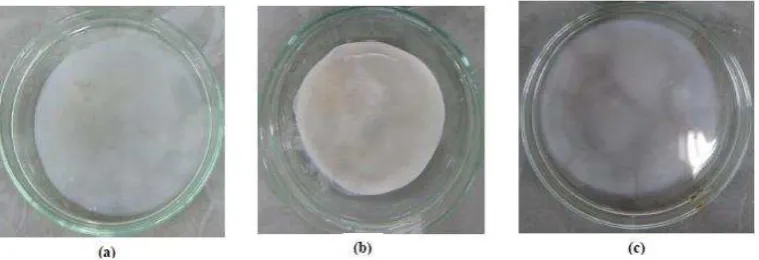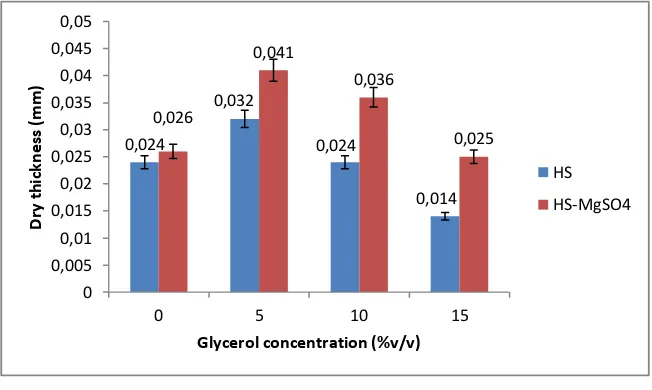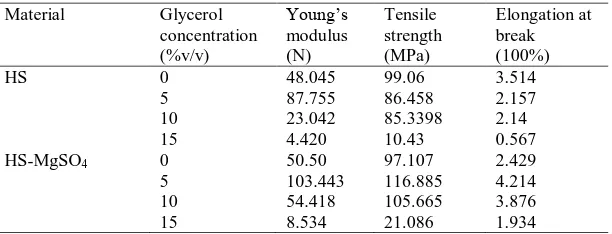IOP Conference Series: Earth and Environmental Science
PAPER • OPEN ACCESS
Glycerol as an additional carbon source for
bacterial cellulose synthesis
To cite this article: Y E Agustin et al 2018 IOP Conf. Ser.: Earth Environ. Sci. 141 012001
View the article online for updates and enhancements.
Related content
Provision of micro-nano bacterial cellulose as bio plastic filler by sonication method Maryam, D. Rahmad, Yunizurwan et al.
-Nanomaterials from bacterial cellulose for antimicrobial wound dressing
E Liyaskina, V Revin, E Paramonova et al.
-Preliminary study on biosynthesis and characterization of bacteria cellulose films from coconut water
A W Indrianingsih, V T Rosyida, T H Jatmiko et al.
1234567890 ‘’“”
ICBBogor 2017 IOP Publishing
IOP Conf. Series: Earth and Environmental Science 141 (2018) 012001 doi :10.1088/1755-1315/141/1/012001
Glycerol as an additional carbon source for bacterial cellulose
synthesis
Y E Agustin, K S Padmawijaya, H F Rixwari and V A S Yuniharto
Chemical Engineering Department, University of Surabaya, Surabaya, Indonesia E-mail : [email protected]
Abstract. Bacterial cellulose, the fermentation result of Acetobacter xylinus can be produced when glycerol was used as an additional carbon source. In this research, bacterial cellulose produced in two different fermentation medium, Hestrin and Scharmm (HS) medium and HS medium with additional MgSO4. Concentration of glycerol that used in this research were 0%; 5%; 10%; and 15% (v/v). The optimum conditions of bacterial cellulose production on each experiment variations determined by characterization of the mechanical properties, including thickness, tensile strength and elongation. Fourier Transform Infra Red Spectroscopy (FTIR) revealed the characterization of bacterial cellulose. Results showed that the growth rate of bacterial cellulose in HS-MgSO4-glycerol medium was faster than in HS-glycerol medium. Increasing concentrations of glycerol will lower the value of tensile strength and elongation. Elongation test showed that the elongation bacterial cellulose (BC) with the addition of 4.95% (v/v) glycerol in the HS-MgSO4 medium is the highest elongation value. The optimum bacterial cellulose production was achieved when 4.95% (v/v) of glycerol added into HS-MgSO4 medium with stress at break of 116.885 MPa and 4.214% elongation.
1.Introduction
Bacterial cellulose (BC) is a strong and ultrapure form of cellulose produced naturally by several species of Acetobacteraceae. Its high strength, purity, and biocompatibility make it of great interest to material science. It is currently used to create materials for tissue engineering, medicine, electronics, paper manufacture, food industry and fabrics. The enhanced mechanical properties of BC occur due to the uniform, continuous and nano-scalar network of cellulosic fibers. These properties are affected by various factors, such as culture conditions, the microorganism and the fermentation media employed. [1][2][3]
2 1234567890 ‘’“”
ICBBogor 2017 IOP Publishing
IOP Conf. Series: Earth and Environmental Science 141 (2018) 012001 doi :10.1088/1755-1315/141/1/012001
2.Materials and Methods
Glycerol p.a was provided by PT. Brataco Chemica with purity 87% (in weight). While strain of Acetobacter xylinus was provided by Agrotekno Sarana Industri. Two different fermentation media were used in this research, Hestrin and Scharmm (HS) media [2%w/v glucose, 0.5%w/v peptone, 0.5%w/v yeast extract, 0.5%w/v disodium phosphate, 0.115w/v citric acid] and HS-MgSO4 [0.115%w/v magnesium sulphate]. Culture media used for BC production were HS modified by repleacing D-glucose with other carbon source, such as glycerol. Concentration of glycerol that used in this research was 0%; 5%; 10%; 15% and 20% (v/v).
2.1.Cultivation media and conditions
Inoculum was cultured for 24 hours in Mc. Cartney bottle containing fermentation media [HS-glycerol or HS-Glycerol-MgSO4] at 26oC and 150 rpm orbital speed. For BC production, static incubations were performed in Erlenmeyer’s flasks for 14 days. To purified BC production, pellicles were rinsed with water to remove the culture medium, and then boiled in 1N NaOH solution at 90oC for 20 minutes in order to eliminate the bacteria cells from the cellulose matrix. Then, pellicles were washed with distilled water till neutralization. Dry weight was measured after drying the films at 50oC till constant weight.
2.2.Analytical method
Bacterial cellulose films were characterized for Fourier transform infrared spectroscopy (FTIR), thickeness and mechanical properties as described below.
2.2.1 Fourier Transform Infrared Spectroscopy
The chemical structure of bacterial cellulose films were analyzed by FTIR (Bruker). The bacterial cellulose produced by Acetobacter xylinus from our research was mixed well with potassium bromide (KBr) powder and press into small tablet.
2.2.2 Thickness measurement
Thickness of each bacterial cellulose film was measured at eight different positions by a thickness gauge, and the values were averaged.
2.2.3 Tensile Strength and Elongation at break
Mechanical properties of the films were investigated using autograph in University of Airlangga, Surabaya. The dimensions of the test specimen were 7 cm x 2 cm. each test was performed in duplicate.
3.Results and Discussions 3.1.Bacterial cellulose production
1234567890 ‘’“”
ICBBogor 2017 IOP Publishing
IOP Conf. Series: Earth and Environmental Science 141 (2018) 012001 doi :10.1088/1755-1315/141/1/012001
Fig 1. Bacterial cellulose production from HS media with addition of (a) 5%v/v(b) 10%v/v(c) 15% v/v glycerol
Fig 2. Bacterial cellulose production from HS-MgSO4 media with addition of (a) 5%v/v (b) 10% v/v (c) 15% v/v glycerol
3.2.Characterization of bacterial cellulose (BC)
4 1234567890 ‘’“”
ICBBogor 2017 IOP Publishing
IOP Conf. Series: Earth and Environmental Science 141 (2018) 012001 doi :10.1088/1755-1315/141/1/012001
Fig 3. Fourier transform infrared (FTIR) spectra of bacterial cellulose on (a) HS (b) HS-MgSO4 media with addition of 5% v/v glycerol
3.3.Thickness measurement
Fig 4 showed the thickness of bacterial cellulose produced on this research using two different media at various glycerol concentrations. The maximum thickness of bacterial cellulose was produce on HS-MgSO4 media with 5% v/v glycerol concentration. Hence, HS-MgSO4 media with additional of glycerol as a carbon source gave maximum thickness when compared with HS media with addition of glycerol. MgSO4 act as a nutrient that can increased growth rate of Acetobacter xylinus.
1234567890 ‘’“”
ICBBogor 2017 IOP Publishing
IOP Conf. Series: Earth and Environmental Science 141 (2018) 012001 doi :10.1088/1755-1315/141/1/012001
3.4.Mechanical test
The mechanical properties of bacterial cellulose at various media were presented in Table 1. For pure BC, the tensile strength was about 99 MPa and the elongation at break was about 3.5%. The value of bacterial cellulose vary depend on situations such as culture time, medium supplement.
Table 1. Mechanical properties of bacterial cellulose at various media
Material Glycerol
Bacterial cellulose composite was successfully prepared in this research. HS-MgSO4 media with addition of glycerol produced thicker films compared to HS media. Bacterial cellulose from HS-MgSO4 with addition of glycerol also produced films with better mechanical properties (higher tensile strength and higher elongation of break number). These results showed that glycerol can be used as a potential substrate for bacterial cellulose production.
5.References
[1] Lin W C, Chun C L, Hsiu J Y, Chao M Y, Shan H H 2013 Carbohydrate Polymers 94 603-611 [2] Czaja W K, Young D J, Kawecki M, Brown R M 2007 Biomacromolecules 8 1-12
[3] Ostadhossein F, Nafiseh M, Gabriel M C, Elnaz T, Fransisco J N M, Belen S C, Jose M L P, Abdolreza S 2015 Materials 8 6401-6418
[4] Vazques A, Maria L F, Patricia C, Miguel G 2013 J. Polym. Environ. 21 545-554 [5] Rani M U and K A Anu A 2013 J. Food. Sci. Technol 50(4) 755-762
[6] Mohammadkazemi F, Azin M, Ashori A 2015 Carbohydrate Polymers 117 518-523


